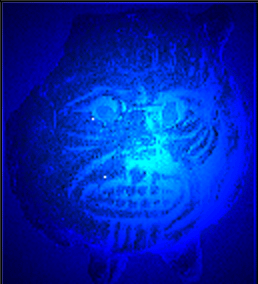
The Epic of Gilgamesh Web Companion




The Recording Process:
Tony Garone - vocals, drum explorations, rhythm electric guitar, keyboards
Anthony Garone - lead electric guitar
Recorded at Cow Pilot Studios
After reading tablet IV, I was struck with an image of a huge monster - and I have to admit that I was rather influenced by Zachariah Sitchin's take on this part of the Gilgamesh Epic. He paints a picture of Huwaw/Humbaba that is extremely fascinating. I'm not sure I agree with his interpretation of this passage but it makes for great inspiration. He describes a giant mechanical menace shooting lasers from its eyes and burning the great cedar trees in the forest. Keep in mind traditional scholarship does not concur with this interpretation.
Inspired by Sitchin's perspective, I was hell bent on making Huwawa sound like a machine. So I used my Alesis drum machine to come up with some interesting patterns and fed it into my Roland JV880. I just kept changing sounds and patterns till I came up with the entire song (just the rhythm tracks).
In fact the song was in this form for weeks as I couldn't come up with any kind of melody or lyrics so I just kept listening to the drum pattern over and over hoping something would gel. I was taken in by this creepy underlying rumble. Eventually I came up with the electric guitar part and sketched out the song. I had Anthony come in and re-record the electric guitar I had originally put down (because he has talent) and the song began to breath life. Conversely, I added the entire beginning (the chant) AFTER I was done with the body of the song.
Months later I added the strange warbley sound in the chorus and the big gong sound in the chant section. It took me days until I came up with a mix I finally happy with. I have never worked so intensely on a song; it's probably the song you won't like. It's not your fault, it just works out that way.
What is this song about?
After befriending Enkidu, Gilgamesh tired of the kingly life of Uruk, and decided to gain fame by conquering Huwawa, the god who guards the Cedar Forest. Enkidu desperately tried to discourage this idea because he knew of Huwawa's powers from his previous life roaming the forests.
Gilgamesh would not hear of this, and insisted they go but before he did, his mother Ninsun makes him promise two things; first, she prays and manages to coerce the sun god Utu/Shamash to protect her son on his perilous journey, and second, she made Enkidu walk before Gilgamesh to protect him.

The image above (created with a cylinder seal), depicts the god Utu/Shamash as he "rises" from Mt. Mashu to bring the golden dawn. He wears the horned crown of divinity and holds a pruning saw in his hand, as the rays of the sun emanate from his shoulder.
The opening chant, "Mountain, Mountain in the sky, break the god and make him die," is an quote from the epic. Gilgamesh and Enkidu chant this as they march toward Huwawa (in some translations anyway). Huwawa emits a "radiance" that the Sumerians call "melam." It is a blinding light or energy that makes Huwawa almost impossible to confront. In one of my correspondences with Dr. Pagan, I asked him to further clarify just exactly what "melam" was. Here's what he wrote:
"It is usually rendered as "splendor," "glamor," or "brilliance." The closest parallel I can think of is the representation of holy men and saints in European art - with shining haloes around their heads. Melam is an aura of power, of majesty, a potent force. In the tale of Gilgamesh and Agga, the melam of Gilgamesh is too powerful to look upon. When he climbs the ramparts of Uruk, the enemy soldiers of Kish (who have been besieging his city) hide their faces - they cannot bear to look upon him. His melam is too powerful. His radiance is blinding. The root of this concept seems to be that of "a strong presence," the idea of individuals who emanate a sense of power, who inspire awe either through authority, wealth, physical size, spiritual
insight, or beauty".

A depiction of the face of Huwawa (I added the "melam")
As they approached Huwawa, Gilgamesh became terrified because he suffered ominous dreams the night before. Enkidu was also afraid but encouraged Gilgamesh to fight. During the approach, Shamash tells Gilgamesh that Huwawa was not wearing all of his "melam", and may be approached. As Enkidu and Gilgamesh surrounded Huwawa, Shamash caused the winds to blow and swirl around him making his "melam" even less effective, allowing our heroes to capture him.
As Huwawa begged for mercy, he offered Gilgamesh all the cedar in the forest - enough to rebuild Uruk. Gilgamesh considered this until Enkidu convinced him otherwise. Enkidu beheaded Huwawa, and the two returned to Uruk heroes with enough timber to build a huge gate for the city.

Gilgamesh (far left) and Enkidu (holding the axe) slay Huwawa/Humbaba depicted on a cylinder seal. Note the seven "dots" above Gilgamesh - traditional explanations tell us that they represent the constellation of Pleiades and that constellation's affiliation with seven gods known as "Sebittu".
The Cuneiform for "Huwawa"

Dr. Pagan explains:
The first sign on the left is hu. As you can see, sign 2 is repeated as sign 3: wa-wa.